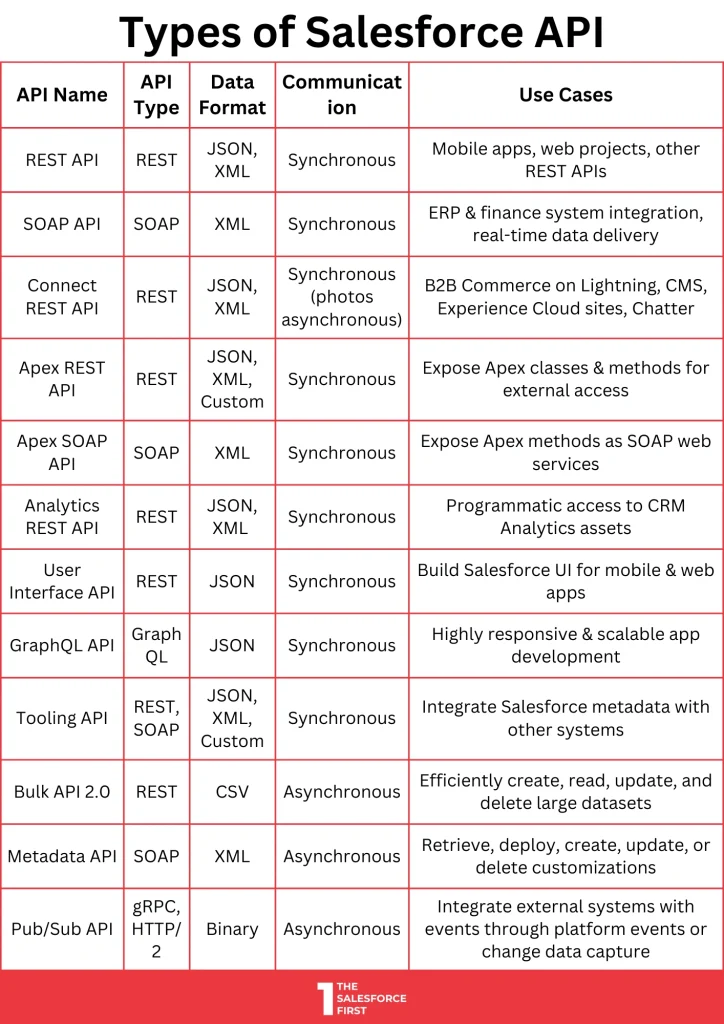Salesforce APIs empower you to unlock the true potential of your CRM by programmatically connecting it to external applications, automating tasks, and extending its functionality beyond the standard user interface.
But with many APIs available, selecting the right one can be daunting.
So, here we’ll delve into various types of APIs and know when to use them.
Table of Contents
What is Salesforce API?
Salesforce API is a set of programming interfaces that allow developers to access and interact with Salesforce data and services. It facilitates seamless integration with other systems, enabling data exchange and automation of business processes, and enhancing overall efficiency and functionality within the Salesforce ecosystem.
Benefits of Using Salesforce APIs
- Enhanced Integration: APIs connect Salesforce to various applications, fostering a unified data ecosystem and streamlined workflows.
- Process Automation: Automate repetitive tasks using APIs to save time and improve efficiency.
- Custom Application Development: Build custom applications that leverage Salesforce data and functionalities.
- Data Access and Manipulation: Programmatically access, create, update, and delete Salesforce data.
Various Types of Salesforce API and Their Use Case

Salesforce offers a comprehensive suite of APIs, each designed for specific use cases. Selecting the right one ensures optimal performance and simplifies integration with various systems. Here’s a breakdown of some common APIs:
REST API
- Definition: The go-to API for most integrations, providing CRUD operations (Create, Read, Update, Delete) on Salesforce data, powerful querying capabilities, and metadata access.
- Use Cases: Ideal for general-purpose integrations, managing data programmatically (CRUD), and building simple data flows with external systems. It excels in mobile and web development due to its ease of use.
- Example: Enrich leads with external data. The REST API lets you connect to an external service, retrieve firmographic details, and update lead records in Salesforce.
SOAP API
- Definition: An established, XML-based API offering a wider range of functionalities compared to REST API, but considered more complex.
- Use Cases: Choose SOAP API for complex integrations requiring functionalities beyond REST’s scope, or when integrating with legacy systems that don’t support modern APIs.
- Example: Integrate a complex on-premise ERP system with Salesforce that necessitates functionalities beyond the capabilities of the REST API.
Connect REST API
- Definition: Designed specifically for social collaboration features within Salesforce communities.
- Use Cases: Utilize the Connect REST API when building integrations for social listening, community management, or custom social features within Salesforce. It allows programmatic access to social data.
- Example: Develop a custom application that leverages the Connect REST API to analyze social media sentiment and update lead records in Salesforce.
Apex REST/SOAP API
- Definition: APIs exposed by custom Apex code running within Salesforce, allowing external systems to access functionalities developed in Apex.
- Use Cases: If you have custom functionalities developed in Apex and want to extend their reach, use Apex REST/SOAP API to expose them to external applications for advanced integrations.
- Example: Create a custom Apex class that processes incoming data from an external system and triggers specific workflows within Salesforce. (50 words)
Analytics REST API
- Definition: Access and manipulate CRM Analytics assets like datasets, lenses, and dashboards programmatically. (50 words)
- Use Cases: For advanced data analysis needs, leverage the Analytics REST API to send queries, access datasets, create and manage lenses and dashboards, and explore other analytical functionalities. (50 words)
- Example: Develop a custom application that retrieves specific datasets from Salesforce Analytics and visualizes them for deeper insights. (50 words)
User Interface API
- Definition: Build user interfaces for creating, reading, updating, and deleting Salesforce records, including list views, actions, and dependent picklists. (50 words)
- Use Cases: Ideal for building custom Salesforce user interfaces for native mobile apps or web applications, leveraging the same API that powers the Salesforce user experience. (50 words)
- Example: Develop a custom mobile app that allows users to create and manage cases directly on their smartphones using the User Interface API. (50 words)
GraphQL API
- Definition: A modern API overcoming the limitations of traditional REST APIs. It offers efficient data retrieval by returning only requested data and fosters complex data relationships. (50 words)
- Use Cases: When dealing with intricate data structures or aiming to optimize data transfer, GraphQL API shines. It reduces round trips and retrieves related resources in a single request. (50 words)
- Example: Build a custom application that displays a user’s profile along with their associated opportunities and contacts in a single request using GraphQL API. (50 words)
Tooling API
- Definition: Manage and integrate Salesforce metadata (customizations) with other systems. It provides granular access to individual components within complex metadata types. (50 words)
- Use Cases: Utilize the Tooling API for tasks like deploying and managing custom code (Apex classes, Visualforce pages), setting up development environments (sandboxes), and analyzing code coverage. (50 words)
- Example: Develop a custom tool that automates the deployment of Apex code changes from a development sandbox to a production environment using the Tooling API. (50 words)
Bulk API 2.0
- Definition: Designed for asynchronous processing of large datasets, enabling efficient creation, reading, updating, and deletion (CRUD) operations on a massive scale. (50 words)
- Use Cases: When dealing with large volumes of data exceeding 2,000 records, Bulk API 2.0 is the way to go. It optimizes data transfer and manages bulk operations efficiently. (50 words)
- Example: Migrate historical sales data from a legacy system into Salesforce in bulk using Bulk API 2.0 for efficient data transfer and processing. (50 words)
Metadata API
- Definition: Programmatically manage and deploy customizations within your Salesforce organization, including custom objects, fields, layouts, and page layouts. (50 words)
- Use Cases: Ideal for automating deployments, migrating customizations between environments (sandboxes and production), and version control of your Salesforce customizations. (50 words)
- Example: Set up a continuous integration/continuous delivery (CI/CD) pipeline that utilizes the Metadata API to automate the deployment of new custom fields and objects from a development sandbox to a production environment. (50 words)
Pub/Sub API
- Definition: Enables real-time, bi-directional data exchange between Salesforce and external systems through event streams based on platform events or changes in Salesforce records. (50 words)
- Use Cases: Utilize Pub/Sub API for scenarios requiring immediate notification of events within Salesforce, such as triggering external workflows when a new opportunity is created or a case is updated. (50 words)
- Example: Integrate a customer support portal with Salesforce using Pub/Sub API. When a customer submits a support ticket on the portal, it triggers a platform event in Salesforce, notifying support agents and initiating the resolution process. (50 words)
How to Select the Right Salesforce API?
Selecting the right Salesforce API hinges on several factors, but here’s a deeper dive to guide your decision:
Functionality Required
Identify the primary actions you need to perform. Are you aiming for basic data exchange (CRUD operations) or more complex interactions?
- CRUD Operations (REST, Bulk API 2.0): For creating, reading, updating, and deleting Salesforce data, REST API and Bulk API 2.0 excel. REST is ideal for smaller datasets and straightforward integrations, while Bulk API shines for massive data transfers.
- Custom Logic Execution (Apex REST/SOAP API): If custom functionalities are developed in Apex code, expose them to external systems using Apex REST/SOAP API to extend their reach for advanced integrations.
- Social Collaboration (Connect REST API): For integrations involving social listening, community management, or custom social features within Salesforce communities, leverage the Connect REST API.
- Data Analysis (Analytics REST API): To access and manipulate CRM Analytics assets like datasets, lenses, and dashboards programmatically, utilize the Analytics REST API for advanced data analysis needs.
Data Volume
Consider the size and frequency of data you’re working with.
- Small Datasets (REST API): For smaller datasets or real-time data exchange, the REST API offers a user-friendly approach.
- Large Datasets (Bulk API 2.0): When dealing with massive volumes of data exceeding 2,000 records, Bulk API 2.0 is specifically designed for efficient asynchronous processing of large datasets.
Integration Complexity
Evaluate the level of intricacy involved in connecting with external systems.
- Simple Integrations (REST API, User Interface API): REST API and User Interface API are well-suited for simple integrations where you need basic data exchange or build custom Salesforce UIs for mobile or web apps.
- Complex Integrations (SOAP API, GraphQL API, Pub/Sub API): For intricate data relationships or real-time data exchange scenarios, consider SOAP API, GraphQL API, or Pub/Sub API. SOAP offers a broader range of functionalities, GraphQL optimizes data retrieval for complex structures, and Pub/Sub enables bi-directional event-driven communication.
Development Skills
Take your team’s experience with different API technologies into account.
- REST API, User Interface API: Widely adopted and relatively easier to learn, REST and User Interface APIs are good choices if your team is comfortable with modern web development practices.
- SOAP API: Established but more complex, SOAP API might require familiarity with XML-based web services.
- GraphQL API: A powerful but newer technology, GraphQL API might require additional learning for development teams.
Remember: Don’t be afraid to combine APIs! Salesforce allows you to leverage multiple APIs within a single integration project to cater to different functionalities and data requirements.
Conclusion
Salesforce’s diverse API ecosystem empowers you to unlock the full potential of your CRM. By understanding the functionalities and ideal use cases of each API, you can build robust integrations, automate workflows, and extend Salesforce’s capabilities to connect with various applications and data sources seamlessly.
Integrating Salesforce with external systems can be complex. An experienced Salesforce integration consultant can guide you through the process, help you choose the right API, develop robust integrations, and optimize your overall Salesforce ecosystem.


